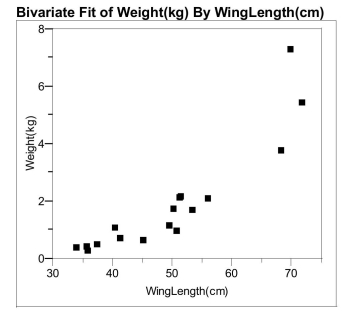The study of prehistoric birds depends on imprints of a prehistoric creature's remains in
stone, commonly known as fossils. To study ancient ecosystems effectively it would be
useful know the actual mass of individual birds, but this information is not preserved in
the fossil record. It seems reasonable that the biomechanics of birds is much the same
today as in the past. For example, today's relationship between the wing length and total
weight of a bird should be very similar to that for birds from the distant past. The wing
lengths of ancient birds are readily obtainable from the fossil record, but the weight is
not. A regression model expressing the relationship between wing length and total
weight of modern birds could be used to estimate the mass of similar prehistoric birds.
Data for some species of modern birds of prey and are given below. Wing length and total weight of modern species of birds of prey
-Biological theory suggests that the  relationship between the weight of these
relationship between the weight of these
animals and their wing length could be
modeled using an exponential model.
Perform the appropriate transformation of
variable(s) and fit an exponential model to
the data.
a) What is the resulting best fit line using
the transformed data?
b) What is the predicted log of bird weight for a species with wing length L = 56.0 ?
Show your work below.
Correct Answer:
Verified
Q2: Assessing the "goodness" of a regression line
Q10: The slope of the least squares line
Q16: One of the properties of Pearson's r
Q17: The data below were gathered on
Q18: The least squares line passes through
Q23: life without their physical capture and
Q24: a) What is the equation of
Q27: The Des Moines Register reported the
Q28: Does the transformed model appear to be
Q29: Assessing the "goodness" of a regression line
Unlock this Answer For Free Now!
View this answer and more for free by performing one of the following actions

Scan the QR code to install the App and get 2 free unlocks

Unlock quizzes for free by uploading documents